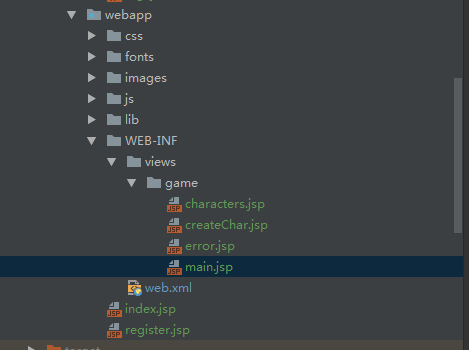本章主要实现注册登陆功能和游戏的主界面。有了游戏的界面,大家能有更直观的认识。
本章我们主要开发的是idlewow-game模块,其实就是游戏的客户端展示层。因为是放置游戏,为了方便,主要使用spring-mvc来开发,整个游戏形式是类似web端的文字mud游戏,会稍带一些图形图片。当然,游戏的客户端可以是多种多样的,也可以使用U3D开发成移动端或者C++/flash/silver light,开发成PC端、网页端、微端等等形式,但需要更多的美术资源。
一、注册登陆和角色创建
首先,我们把idlewow-game的框架搭建好,因为也是spring-mvc项目,可以基本参照前面的rms模块。各种配置,这里就不再赘述了。可以先把源代码下载下来,对照着看。
一)添加jsp页面
为了便于理解,这里我们先添加个首页,即登陆页面。其实就是一个背景图,带上登陆输入框和注册、登陆按钮。如下图,是我从网上随便找的一个背景图。这里,注册和登陆页面的展示,不需要经过controller做什么处理,直接在"/webapp/"目录下添加jsp页面即可。代码如下,比较简单,注意里面引用的css和js就不粘贴了。

<%@ page contentType="text/html;charset=UTF-8" language="java" %> <% String path = request.getContextPath();%> <html> <head> <title>挂机魔兽</title> <link rel="stylesheet" href="<%=path%>/css/wow/base.css?v=0714"> <script type="text/javascript" src="/js/jquery.min.js"></script> <style> .input-wow { background: rgb(80, 80, 80); border: gray; border-radius: 4px; color: white; } </style> </head> <body> <div class="bg bg-index"></div> <div style="text-align:center; width:100%;position:relative;top:58%;"> <form id="form-login" method="post"> <div style="margin: 10px;"> <input type="text" name="username" placeholder="请输入账号" class="input-wow"/> </div> <div style="margin-top: 50px;"> <input type="password" name="password" placeholder="请输入密码" class="input-wow"/> </div> <div style="margin: 20px;"> <button type="button" class="btn-wow" onclick="login();">登 陆</button> <button type="button" class="btn-wow" onclick="location.href='/register.jsp';">注 册</button> </div> </form> </div> <script type="text/javascript" src="<%=path%>/js/wow/index.js?v=0714"></script> </body> </html>

<%@ page contentType="text/html;charset=UTF-8" language="java" %> <html> <head> <title>注册账号</title> <script type="text/javascript" src="/js/jquery.min.js"></script> </head> <body> <form id="form-register" method="post"> <div> <label>账号:</label> <input type="text" name="username" id="username"/> </div> <div> <label>密码:</label> <input type="password" name="password" id="password"/> </div> <div> <label>确认密码:</label> <input type="password" name="password2" id="password2"/> </div> <div> <button type="button" onclick="register();">注册</button> <button type="button" onclick="history.go(-1);">返回</button> </div> </form> <script type="text/javascript" src="/js/wow/register.js"></script> </body> </html>

好了,现在页面有了,接下来,在注册页面点击“注册”和登陆页面点击“登陆”按钮时,就需要controller来做后台逻辑处理了。
二)hessian客户端配置
在添加controller前,我们先把hessian客户端配置好。注意,在调用hessian接口的客户端,同样需要在pom中引用hessian的包。
因为game模块作为游戏的客户端展示层,本身不访问底层数据库,这里就需要调用上一章提供的hessian服务,来完成注册和登陆功能。hessian的服务端配置上一章已经讲过了,在调用时,上一章我们直接使用代码生成代理类进行测试。实际使用时,一般只需要配置一个xml文件,就可以在项目中引用对应的对象。
在game模块的"/resources/properties"目录下,添加 hessian.properties 文件,用来存放 hessian 服务的url地址,内容如下:
server.url=http://localhost:20000
再在"/resources/spring"目录下,添加 hessian-client.xml 文件,用来配置需要引用的接口地址(即hessian服务端暴露出的接口),内容如下:
<beans xmlns="http://www.springframework.org/schema/beans" xmlns:xsi="http://www.w3.org/2001/XMLSchema-instance" xmlns:util="http://www.springframework.org/schema/util" xsi:schemaLocation=" http://www.springframework.org/schema/beans http://www.springframework.org/schema/beans/spring-beans.xsd http://www.springframework.org/schema/util http://www.springframework.org/schema/util/spring-util.xsd"> <util:properties location="classpath:/properties/hessian.properties" id="hessian"/> <bean id="userService" class="org.springframework.remoting.caucho.HessianProxyFactoryBean"> <property name="serviceUrl" value="#{hessian['server.url']}/remoting/UserService"/> <property name="serviceInterface" value="com.idlewow.user.service.UserService"/> </bean> <bean id="characterService" class="org.springframework.remoting.caucho.HessianProxyFactoryBean"> <property name="serviceUrl" value="#{hessian['server.url']}/remoting/CharacterService"/> <property name="serviceInterface" value="com.idlewow.character.service.CharacterService"/> </bean> </beans>
然后,在spring的上下文配置文件 applicationContext.xml 中,将这段配置引入即可,即:
<beans> ........ <import resource="hessian-client.xml"/> ........ </beans>
全部配置完成,就可以在项目中引用并调用hessian服务了。注意,以后服务端每次添加新的接口,都需要在服务端和客户端的配置文件添加配置。
三)添加controller
页面完成后,点击“注册“和”登陆“按钮时,需要后台进行相应的逻辑处理,在spring-mvc框架下,就需要新建一个controller。
在com.idlewow.game.controller包下,新建一个类GameController,内容如下:

package com.idlewow.game.controller; import com.idlewow.character.model.Character; import com.idlewow.character.service.CharacterService; import com.idlewow.common.model.CommonResult; import com.idlewow.game.GameWorld; import com.idlewow.user.model.UserAccount; import com.idlewow.user.service.UserService; import com.idlewow.util.cipher.MD5Util; import org.apache.commons.lang3.StringUtils; import org.apache.logging.log4j.LogManager; import org.apache.logging.log4j.Logger; import org.springframework.beans.factory.annotation.Autowired; import org.springframework.stereotype.Controller; import org.springframework.web.bind.annotation.RequestMapping; import org.springframework.web.bind.annotation.RequestMethod; import org.springframework.web.bind.annotation.ResponseBody; import org.springframework.web.servlet.mvc.support.RedirectAttributes; import javax.servlet.http.HttpServletRequest; import javax.servlet.http.HttpSession; import java.util.List; import java.util.regex.Pattern; @Controller @RequestMapping("/game") public class GameController { private static final Logger logger = LogManager.getLogger(GameController.class); @Autowired UserService userService; @Autowired CharacterService characterService; @Autowired private HttpSession httpSession; @Autowired private HttpServletRequest request; @ResponseBody @RequestMapping("/register") public Object register(String username, String password) { String ip = request.getRemoteAddr(); String regex = "[a-zA-Z0-9]{6,20}"; if (!Pattern.matches(regex, username)) { return CommonResult.fail("用户名应为6-20位英文字母、数字"); } if (!Pattern.matches(regex, password)) { return CommonResult.fail("密码应为6-20位英文字母、数字"); } String cipher = MD5Util.md5(password); CommonResult commonResult = userService.register(username, cipher, ip); return commonResult; } @ResponseBody @RequestMapping(value = "/login", method = RequestMethod.POST) public Object login(String username, String password) { String cipher = MD5Util.md5(password); CommonResult commonResult = userService.login(username, cipher); if (commonResult.isSuccess()) { UserAccount userAccount = (UserAccount) commonResult.getData(); httpSession.setAttribute(GameWorld.SK_User, userAccount); } return commonResult; } @RequestMapping("/characters") public Object characterList(RedirectAttributes redirectAttributes) { try { UserAccount userAccount = (UserAccount) httpSession.getAttribute(GameWorld.SK_User); String userId = userAccount.getId(); CommonResult commonResult = characterService.getUserCharacters(userId); if (!commonResult.isSuccess()) { throw new Exception("获取角色列表失败!" + commonResult.getMessage()); } List<Character> list = (List<Character>) commonResult.getData(); request.setAttribute("characters", list); return "/game/characters"; } catch (Exception ex) { redirectAttributes.addFlashAttribute("error", ex.getMessage()); return "redirect:/game/error"; } } @RequestMapping("/createChar") public Object createChar() { return "/game/createChar"; } @ResponseBody @RequestMapping(value = "/createChar", method = RequestMethod.POST) public Object createChar(String name, Integer faction, Integer race, Integer job) { UserAccount userAccount = (UserAccount) httpSession.getAttribute(GameWorld.SK_User); String userId = userAccount.getId(); if (StringUtils.isBlank(name)) { return CommonResult.fail("角色昵称不能为空!"); } if (name.length() < 2 || name.length() > 10) { return CommonResult.fail("角色昵称应为 2-10 个字符!"); } String pattern = "^[\\u4e00-\\u9fa5_a-zA-Z0-9]+$"; if (!Pattern.matches(pattern, name)) { return CommonResult.fail("角色名称只能包含汉字、英文字母、数字、下划线!"); } if (faction == null) { return CommonResult.fail("请选择阵营!"); } if (race == null) { return CommonResult.fail("请选择种族!"); } if (job == null) { return CommonResult.fail("请选择职业!"); } CommonResult commonResult = characterService.createCharacter(userId, name, faction, race, job); return commonResult; } @RequestMapping("/main") public Object main(String characterId, RedirectAttributes redirectAttributes) { if (characterId == null) { characterId = httpSession.getAttribute(GameWorld.SK_CharId).toString(); } CommonResult commonResult = characterService.find(characterId); if (commonResult.isSuccess()) { Character character = (Character) commonResult.getData(); httpSession.setAttribute(GameWorld.SK_CharId, characterId); request.setAttribute("character", character); return "/game/main"; } else { redirectAttributes.addFlashAttribute("error", commonResult.getMessage()); return "redirect:/game/error"; } } @RequestMapping("/error") public Object error() { return "/game/error"; } }
其中,userService和characterService就是对hessian接口的引用。这里注解使用@Autowired或者@Resource均可。具体区别可以百度一下。
@Autowired
UserService userService;
@Autowired
CharacterService characterService;
controller中的方法,对应提供了“注册”、“登陆”、“获取角色列表”、“创建角色”、“进入游戏主界面”、“错误页面”几个功能。其中,还需要对应的创建几个页面,目录结构如下图。页面代码就不粘贴了,可以下载源码查看。这里需要注意的是,由controller路由的页面,根目录是"/WEB-INF/views/”,这是我们在spring-mvc.xml中的视图解析节点配置的,属于mvc的路由机制。而前面的index.jsp和register.jsp,是直接从文件目录结构访问的,未参与mvc路由。

四)数据库设计
项目中用到的sql建表语句等,都在idlewow-doc目录下。这里账号表和角色表比较简单,sql里也有相应的注释。这里需要注意的是,角色表 user_character 中,有一个字段 extra_info。这个字段主要以json文本的形式存储一些缓存数据。比如角色身上的装备信息,角色所在的地图,等等等等。
试想一下,在游戏世界中,一个角色可能会频繁的进行更换装备、切换地图等操作,这些信息都需要记录。如果游戏中每个角色有此类动作时,都进行更新写库,对数据库会造成巨大的压力。因此这部分数据,会在游戏一开始时,读取到缓存中(比如redis)。在游戏进行时,只需要更新缓存数据。在游戏退出时,再将缓存中的数据写回数据库。
二、效果演示

小结
本章主要实现了游戏的主界面,但界面上的角色信息、战斗记录、地图信息及怪物信息等,目前都是静态文本,接下来只要一点点往上添加就行了。
本章的代码可能会有部分冗余,因为是从我已经开发好的分支上,直接拷贝过来的。有些代码可能目前还用不到,或者后期会有改进,有些地方是我还没想好最终会怎么做还在思考。看代码的时候,重点关注本章需要实现的内容就可以了,有些不合理的地方也可以自己发挥。
源码下载地址:https://545c.com/file/14960372-403554557
本文原文地址:https://www.cnblogs.com/lyosaki88/p/idlewow_11.html
项目交流群:329989095
